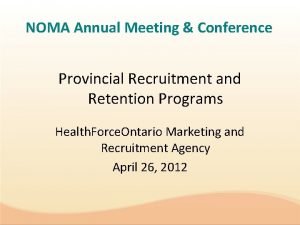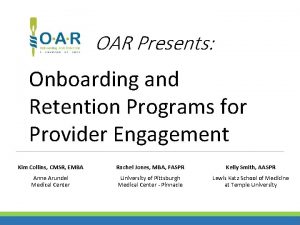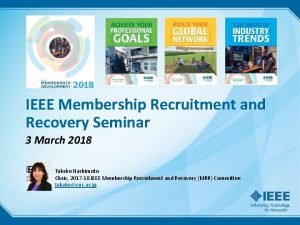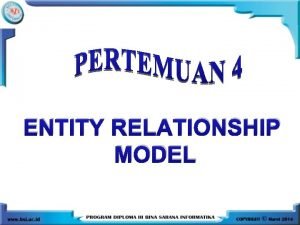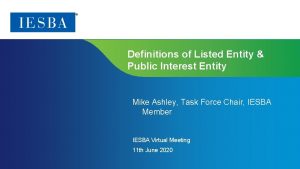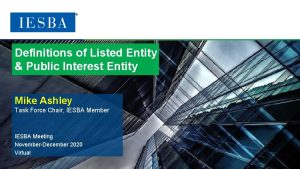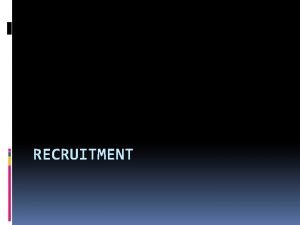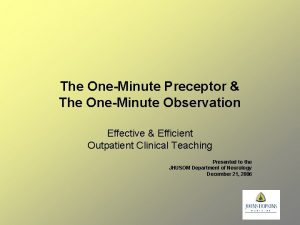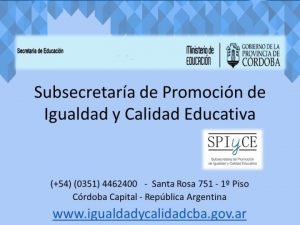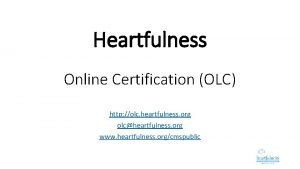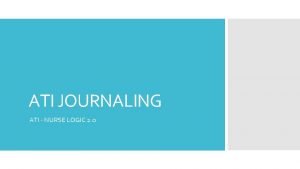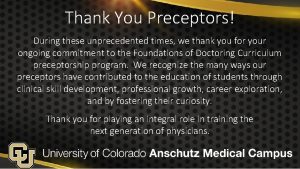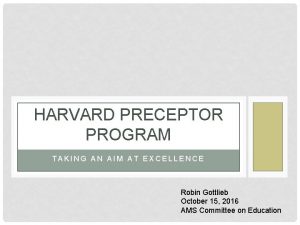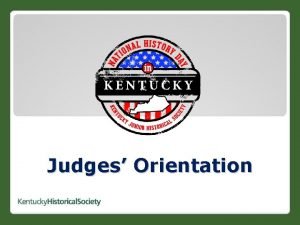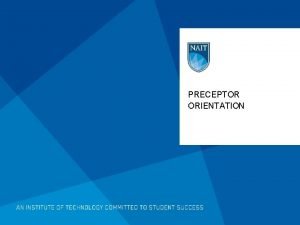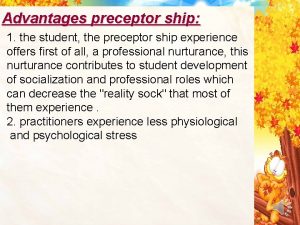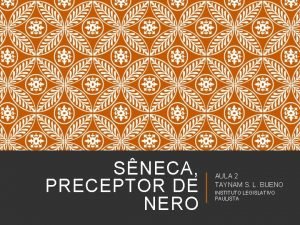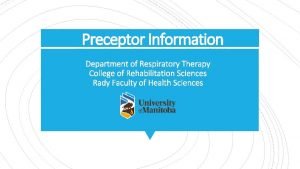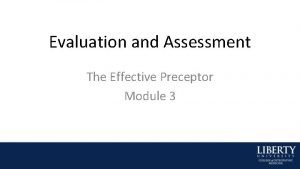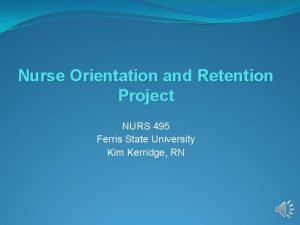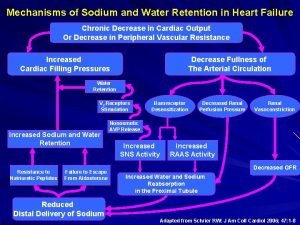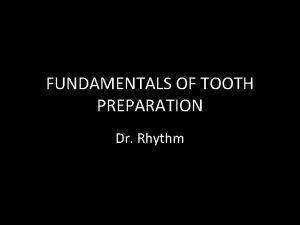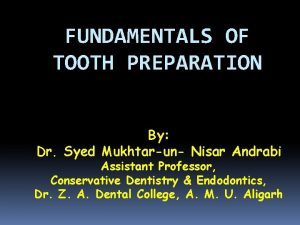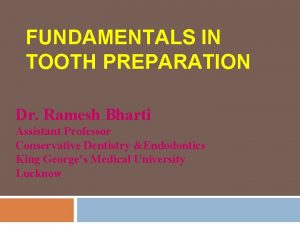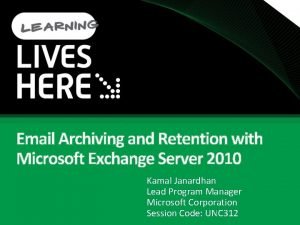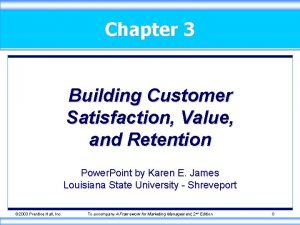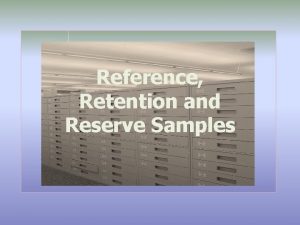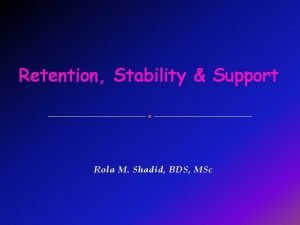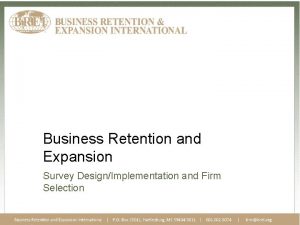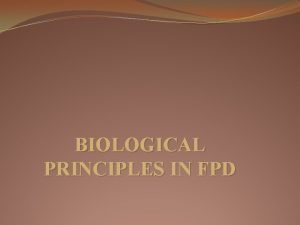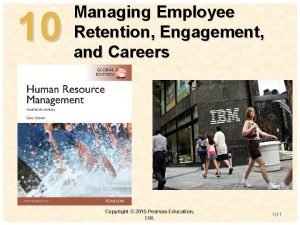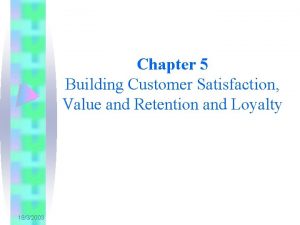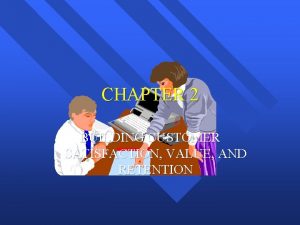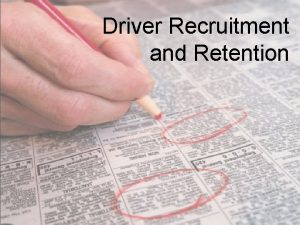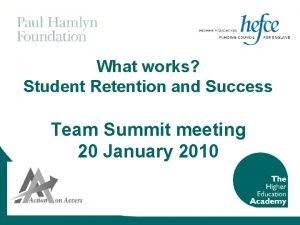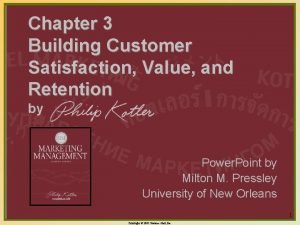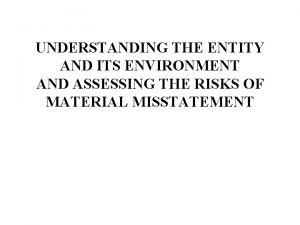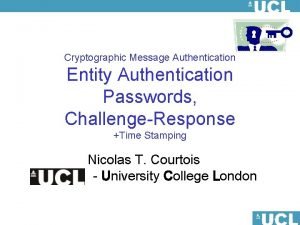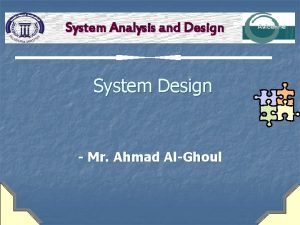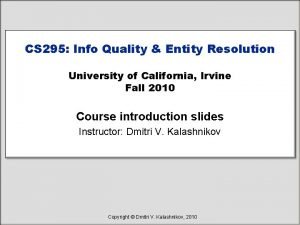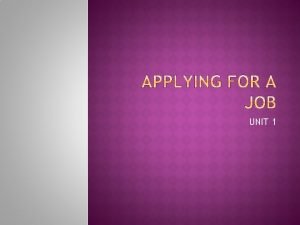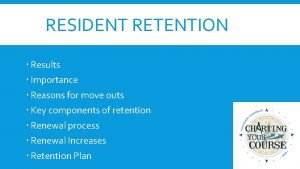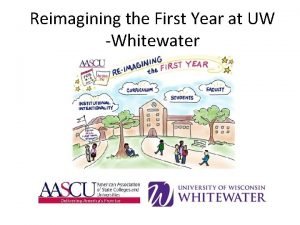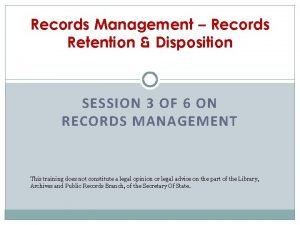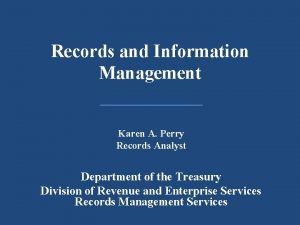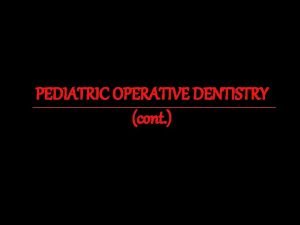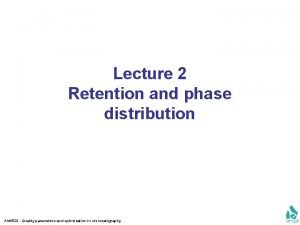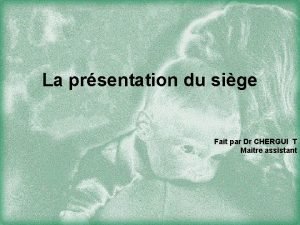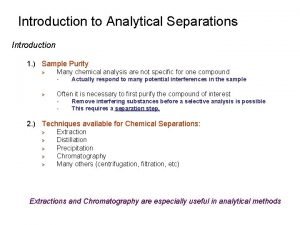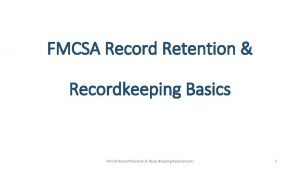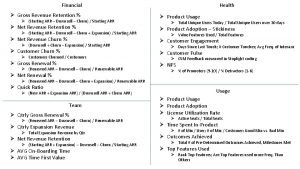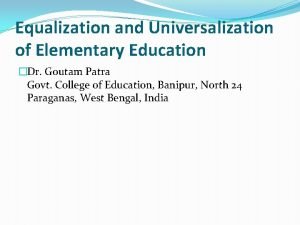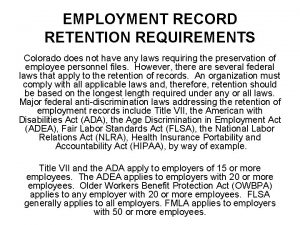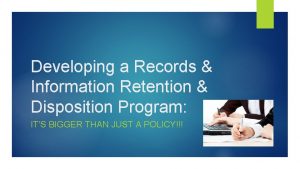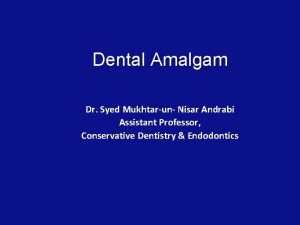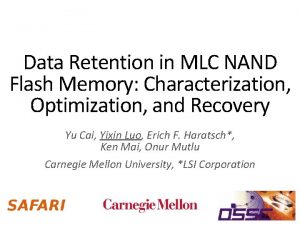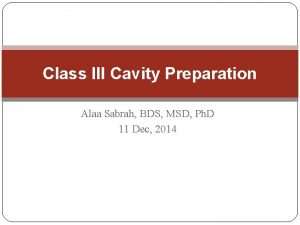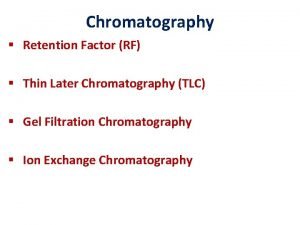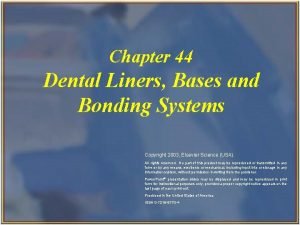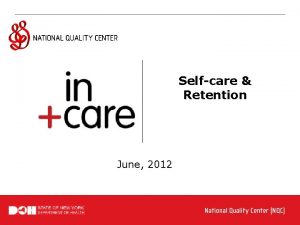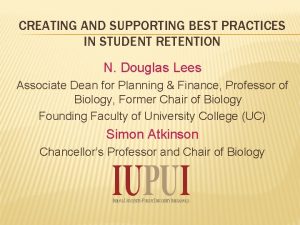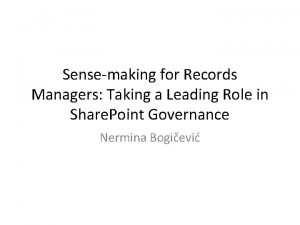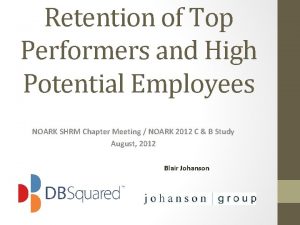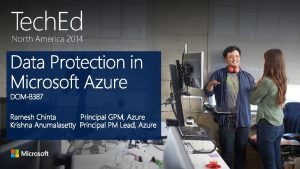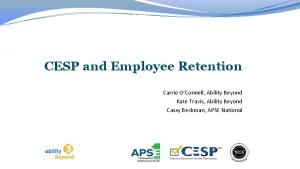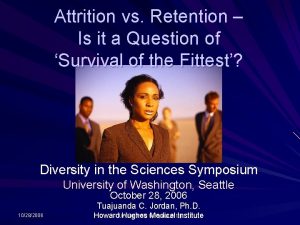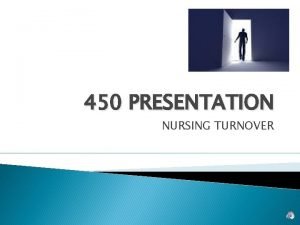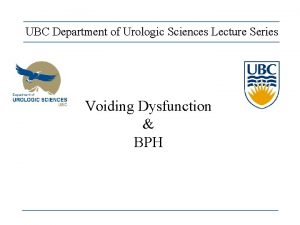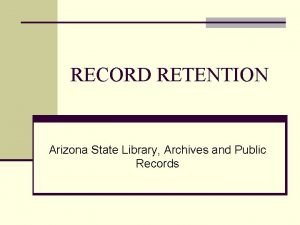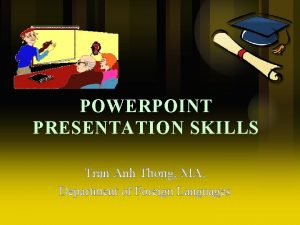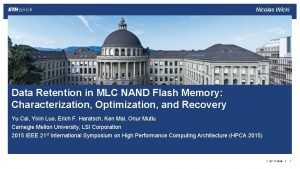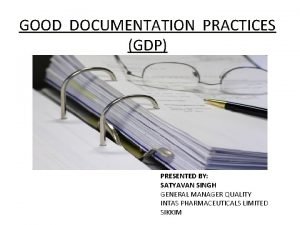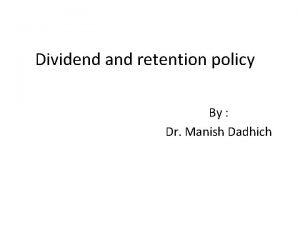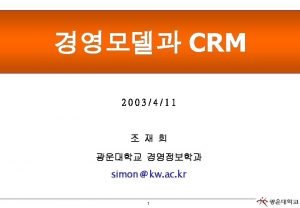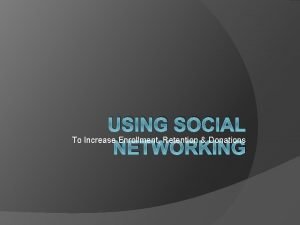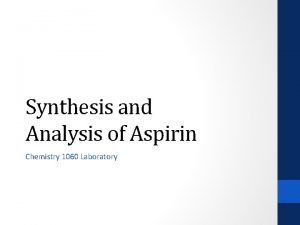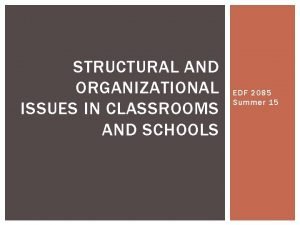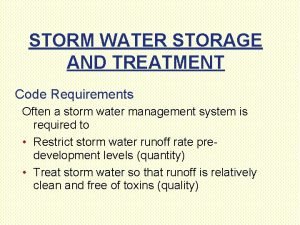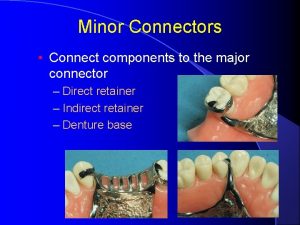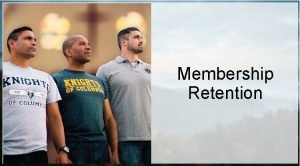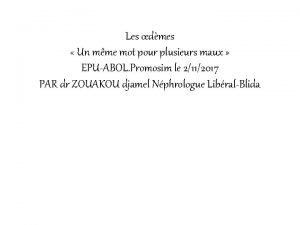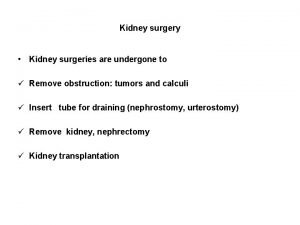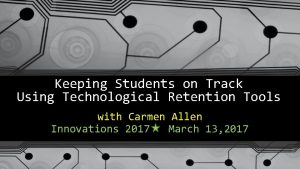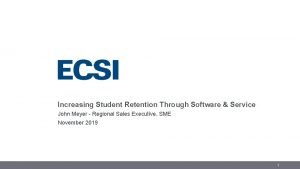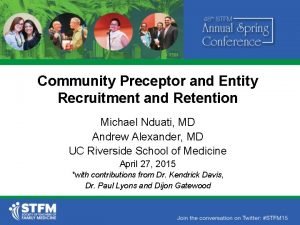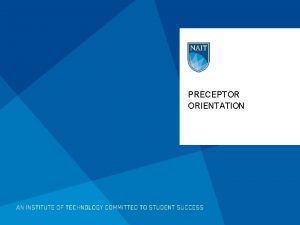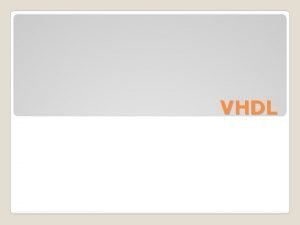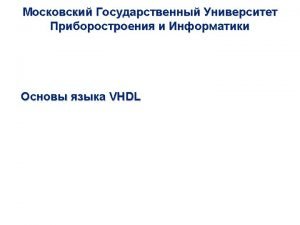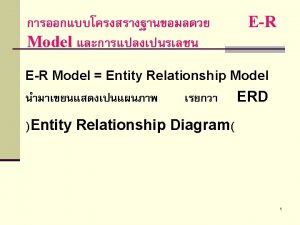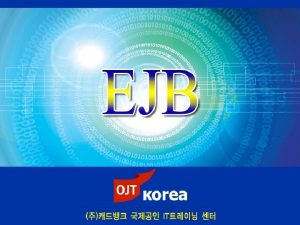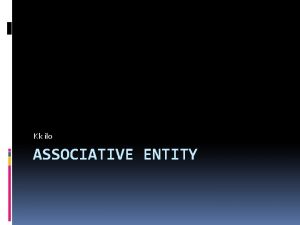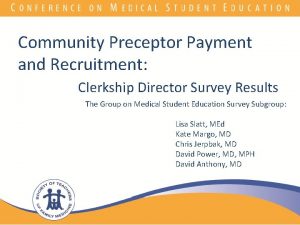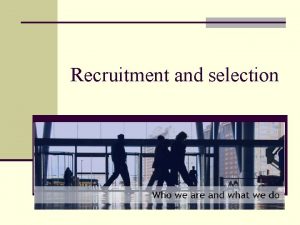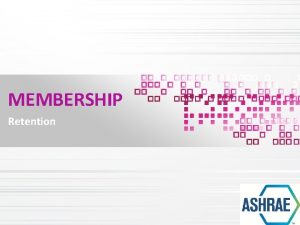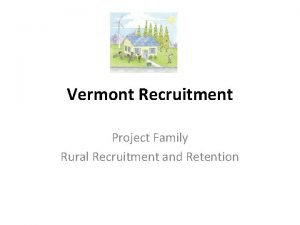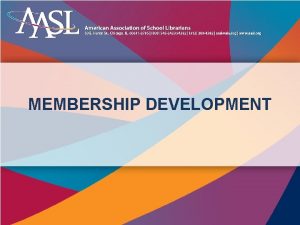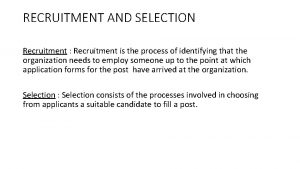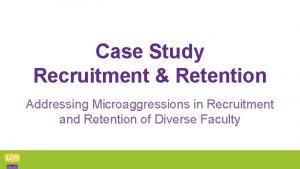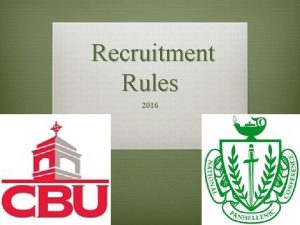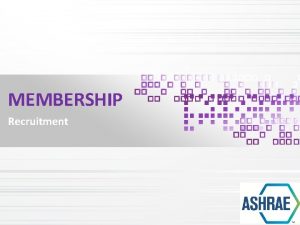Community Preceptor and Entity Recruitment and Retention Michael



















































































































- Slides: 115

Community Preceptor and Entity Recruitment and Retention Michael Nduati, MD Andrew Alexander, MD UC Riverside School of Medicine April 27, 2015 *with contributions from Dr. Kendrick Davis, Dr. Paul Lyons and Dijon Gatewood

Introduction to Contributors • Michael Nduati, MD, MBA, MPH (mnduati@ucr. edu) – Associate Dean, Clinical Affairs – LACE Co-Director – 2014 STFM New Faculty Scholar & MSEDI Fellow • Andrew Alexander, MD (andrew. alexander@ucr. edu) – Clerkship Director – Former Mayor • Kendrick Davis, Ph. D: Director of Medical Education; LACE Co-Director • Paul Lyons, MD: Sr. Associate Dean of Education; Chair of Family Medicine • Dijon Gatewood: UCR SOM Intern; UCR Pre-med undergraduate student

Actual Preceptor Survey LACE Motivation Scale – Preceptor (Modified from Baldor, Blair, Warfield, & Shea; 2001) Instructions: For the following questions, please respond regarding the importance of each to your experience with LACE. Indicate how important each item is from your perspective Using the following response scale: Section A: Potential current benefits to organization Directions: The following section contains items which require you to think about potential organizational benefits that may currently motivate you to participate in the LACE program. Please rate the importance of each item below. Not at all important Minimally Important Somewhat Important Moderately Important Very Important Extremely Important 1. The LACE program is personally important to me in providing an employment pipeline for my organization. 1 2 3 4 5 6 2. The LACE program is personally important to me for providing practice improvement at my clinical site. 1 2 3 4 5 6 3. The LACE program is important in providing an employment pipeline for my organization as a whole. 1 2 3 4 5 6 4. The LACE program is important in providing practice improvement for my organization as a whole. 1 2 3 4 5 6 Comments (Please provide your thoughts on other potential benefits to your organization):

Preceptor Survey Results

Analysis of Results: Preceptors (n=57) • The 4 lowest rated items centered on appreciation & recognition (from peers being less important than from medical students) • Getting CME credit [3. 24] and providing practice improvement [3. 27] were also low • The highest rated item [5. 29] was “getting personal satisfaction from giving back to the medical profession” • The other high scores centered on things that provided intrinsic value to the CPs

Preceptor Feedback • Benefits to organization: – “My group is aging – we love the concept of ‘growing our own’ replacements. ” – “Influencing students with Inland Empire connection is an opportunity. ” • Benefits for them: – “Having the opportunity to see students develop into physicians gives me tremendous pleasure. Keeps me relevant. ”

Preceptor Feedback (cont. ) • Benefits for them (cont. ): – “It takes time and effort to teach, but I enjoy teaching and it is a rewarding experience. ” – “I get some satisfaction from teaching and from ‘paying back’ to the system of physician education. ” • Potential future motivators: – “Having access to the SOM library and doing more faculty development. ”

Future Directions • Provide more faculty development and training to solidify the “teaching identity” • Provide more non-monetary extrinsic rewards for our CPs • Examine the differences in responses between practice types (i. e. County vs. IPA vs. large/small physician partnership) • Examine the differences (if any exist) in motivating factors between LACE and CILC physicians

1. 2. 3. 4. 5. References Baldor, Robert A. , W. Blair Brooks, Marji Erickson Warfield, and Kathleen O‘Shea. "A Survey of Primary Care Physicians' Perceptions and Needs regarding the Precepting of Medical Students in Their Offices. " Medical Education (2001): 78995 Bowen, Judith L. , and David M. Irby. "Assessing Quality and Costs of Education in the Ambulatory Setting. " Academic Medicine 77. 7 (2002): 621 -80 Grayson, Martha S. , Martin Klein, Javier Lugo, and Paul Visintainer. "Benefits and Costs to Community-based Physicians Teaching Primary Care to Medical Students. " Journal of General Internal Medicine 13. 7 (1998): 485 -88 Kumar, Ashir, David J. Kallen, and Thomas Mathew. "Volunteer Faculty: What Rewards or Incentives Do They Prefer? " Teaching and Learning in Medicine 14. 2 (2002): 119 -24 Starr, Susan, Warren Ferguson, Heather-Lyn Haley, and Mark Quirk. "Community Preceptors’ Views of Their Identities as Teachers. " Academic Medicine 78. 8 (2003): 820 -5

Community Preceptor Recruitment and Development Darin Brink, MD Kathy Brooks, MD University of Minnesota STFM April 2015

Programs who Pay Preceptors

What Community-based Preceptors Want in Teaching Medical Students • Communication and contact with the department • Professional development • Feedback Hashim et al. Educ Health 2010

Summary • Increasingly preceptors are being reimbursed for teaching medical students and other learners • Face to face visits create/ sustain the relationships that retain preceptors and allow for critical feedback and navigating issues with challenging students





http: //ekstasispeerconsultations. com/

Resources: Video • Precepting, a bad example: http: //www. youtube. com/watch? v=937 G 0 m 5 SUs. I • Precepting, a good example: http: //www. youtube. com/watch? v=l. Ceyzp. U 7 PMw • One Minute Preceptor and Giving Feedback: http: //www. practicaldoc. ca/teaching/practical-prof/teaching-nutsbolts/one-minute-preceptor/ • Feedback: http: //www. meded. umn. edu/meds/resources/documents/Providing Feedbackto. Med. Students. pdf • STFM: http: //www. youtube. com/user/STFMVideos? feature=watch

Resources: Teaching • Mc. Cormick LH. Precepting preclinical students. Fam Med. 1999 Apr; 31(4): 235 -6. Pub. Med PMID: 10212760. (http: //www. stfm. org/Fullpdf/april 99/ftobtofm. pdf) • Seibert C, Haq C. Precepting preclinical students. Fam Med. 1999 May; 31(5): 313 -4. Pub. Med PMID: 10407706. (http: //www. stfm. org/Fullpdf/may 99/ftobtofm. pdf) • Irby DM, Wilkerson L. Teaching when time is limited. BMJ. 2008 Feb 16; 336(7640): 384 -7. Pub. Med PMID: 18276715. (http: //www. bmj. com/cgi/content/full/336/7640/384)

Preceptors in a Community -Based Program Karen Myers, ARNP STFM MSE 2015 Special Topic Breakfast


Dear XXXXXXX Thank you for taking the time to discuss your interest in preceptoring the first and second year medical students at Florida State University College of Medicine. Enclosed please find an application for a faculty position with FSU COM. This will need to be completed and returned to XXXXXX at the Tallahassee Regional Campus for processing. If you have any questions, please contact XXXXX or by phone at XXXX. Once the application is complete, I will contact you to set up another meeting to discuss an orientation program. I would also like to offer a tour of the campus at your convenience. Thank you for your interest and I look forward to working with you in the future. Karen Myers, ARNP Assistance Professor Department of Family Medicine and Rural Health Director of Preceptors Florida State University College of Medicine 1115 West Call Street Tallahassee, Fl 32306 karen. myers@med. fsu. edu (850) 644 -1233

Your Doctor Is a Teacher • Your doctor is one of a select group of community physicians chosen by the Florida Stated University College of Medicine (FSUCOM) to teach medical students. • The students who are training here are learning to use clinical and patient communication skills by working closely with doctors like yours. • As a patient, you should know that the presence of medical students in this office indicates that your doctor has been identified not only as an excellent physician, but also as an exceptional role model and teacher. • “The best in patient care is provided by those who teach. ”

Benefits include: (1) CME credit provided, (2) $500 per student per semester (3) Faculty Status with FSUCOM (4) Access to the FSUCOM library resources (includes electronic resources) (5)Resources (e. g. books and web resources on clinical teaching) (6) Faculty Development programs to help you enhance your clinical teaching skills

Maguire Medical Library Quick Tips Clinical Faculty Library Links: Getting Started http: //med. fsu. edu/library

Challenges Tallahassee is a small medical Community Share preceptors with FSU Tallahassee Campus 3 rd and 4 th year medical students, FSU and FAMU ARNP programs, UF clinical experience… Increased regulations for credentialing students at various locations Preceptor personality issues Burn-out issues with preceptors Student issues

Extending the Faculty Reach: Best Practices for Recruiting, Developing & Retaining Volunteer Community Faculty Scott Renshaw, MD Jennifer Custer Jennifer Burba Shannon Cooper Indiana University Department of Family Medicine fmclerk@iupui. edu STFM Annual Meeting May 2013 Presented at the Society of Teachers of Family Medicine Annual Conference STMay 2013

Recruitment – IU • • Tomato – Tomahto: Community Faculty – Preceptor CME Credit – – • IU Email Account – – – • Ruth Lilly Medical Library – Med. Pub, journals, etc. Free computer software and upgrades (approximate $4, 000 value) Lynda Online Training Library® (a subscription value of $375 per year) Oncourse – IU learning management software program, houses course materials, lectures, ppt slides, etc. Grand Rounds – IUSM clinical departments offer an archive of all grand rounds. Professional/Faculty Development – – • Everyone can do this - One Clerkship student: AAFP = 20 hours of prescribed credit per year; AOA = 60 hours Category 2 CME. Everyone can do this - FMCases: AAFP = 60 AAFP prescribed CME hours; AOA = 60 Category 2 CME hours. IUSM appointed faculty can register for CME at IUSM through the CME website. Additional CME available through our own online modules. Offered by the Department of Family Medicine in conjunction with IAFP. Available through the IUSM Dean’s Office for Faculty Affairs. IUSM Identification Card/“Jag. Tag” – Discounts available through this card include discounts for cell phone plans, airport parking at the Indianapolis International Airport, rental car, hotel, etc.


Retention – DFM • Welcome Packet – • “Thanks”giving cards – – • Top 5 community faculty based upon student evaluations receive plaque Pay registration and travel to Annual IAFP Meeting Portfolio and certificate with appointment renewal – – • Send report at end of each rotation Annual Outstanding Community Faculty Awards – • • Sent at end of first year Report CME to AAFP – • Perks reminder insert IU Community Faculty window decal Clinical Teaching Handbook – • Letter, certificate, Teaching Medical Students Handbook Sent at first appointment renewal Important to acknowledge their participation; shows patients their affiliation with the medical school Maintaining the relationships – – External partners develop relationships with the community faculty member – Lynn O male/female IUSM body fmclerk@iupui. edu email address

What We Do 1. Credentials check (after online profile form submitted - https: //fammdata. iusm. iu. edu/presentation/lfserver/Preceptor_Profile) – Board Certification • MD: https: //www. theabfm. org/diplomate/find. aspx • DO: http: //www. osteopathic. org/osteopathic-health/find-a-do/Pages/default. aspx – Medical License: https: //mylicense. in. gov/EVerification/Search. aspx – Medical Exclusions: http: //exclusions. oig. hhs. gov/search. aspx 2. Email Profile Form & Honor Code 3. Submit University HR documentation

In Demand On Demand An Online Faculty Development Curriculum for Community Faculty Matthew Holley, MA, MS Scott E. Renshaw, MD Mary E. Dankoski, Ph. D Megan M. Palmer, Ph. D Indiana University School of Medicine STFM Annual May 2013 Presented at the Society of Teachers of Family Medicine Annual Conference May 2013

Online Teaching Development Modules

Clinical Teaching

Grading and Giving Feedback

Discussion Thank you! Matt Holley, MA, MS maholley@iupui. edu www. iufammed. iupui. edu

Community Preceptor Payment for Teaching: Results from the 2012 CERA Survey of Clerkship Directors STFM Med Ed 2013 Chris Jerpbak MD Katie Margo MD David Anthony MD Lisa Slatt, MEd David Power, MD, MPH Mimi Tarn MD, Ph. D

CD Surveys 2010 -11 2012 · 69% response rate: 92/133 respondents · 66% response rate: 88/134 respondents · 65% Public, 34% Private, 1% Military · 67% Public, 33% Private · All respondents are MDs · The median year of graduation from residency was 1993. The range was 1974 -2011.

2012 CERA CD Survey Respondents

Preceptor Payment Results 2010 -11 2012 • 16. 3% (n=15) pay • 21. 6% (n=19) pay their preceptors • 10 public, 5 private • 12 public, 7 private medical schools • Payment ranges: $93 • Payment ranges: $20 -500/week

Programs who Pay Preceptors

Reasons to Pay

Reasons not to pay (n=60) Reason Number of respondents Do not have the funds 57 Do not need to pay to get adequate preceptors 29 Do not want to set a precedent 29 • 57/60 don’t have funds • Half don’t need to pay to get preceptors • Half don’t want to set a precedent

• If you had the resources, would you pay? n=62 – Yes – 76% – No – 24% • Are you actively trying to find funds? n=47 – Yes – 15% – No – 85%

Disadvantages to paying – All respondents n=83 Weighted Score* Devalues teaching 20 No disadvantages 56 Precedence for region 41 Precedence for department 64 Precedence for institution 75 Cannot afford 184 -10 10 First Choice 30 Second Choice 50 70 Third Choice *Weighted score represents sum of responses where each First Choice is given a score of 3, each Second Choice is given a score of 2, and each Third Choice is given a score of 1.

Comparison of paying and non-paying clerkship directors ǂ † Responses were based on a 4 -point Likert scale, higher scores -> greater agreement. ǂ Responses to question identifying whether preceptors are paid for other types of learners

Conclusions • 2/3 of those who pay report competition from other learners, compared to only 1/3 of those who do not pay • Of the CDs who do not pay – Almost all cite lack of funds – Half indicate they do not want to set a precedence – Yet 76% say they would pay if they had the resources

References 1. 2. 3. 4. 5. 6. 7. 8. 9. Bowen JL and Irby DM. Assessing quality and costs of education in the ambulatory setting: A review of the literature. Acad Med 2002; 77: 621 -680. Adams M and Eisenberg JM. What is the cost of ambulatory education? JGIM 1997 April; 12(S 2): S 104 -S 110. Latessa R, Beaty N, Landis S, Colvin G, Janes, C. The Satisfaction, Motivation, and Future of Community Preceptors: The North Carolina Experience. Acad Med 2007; 82 (7): 698 -703. Starr S, Ferguson W, Haley H, Quirk M. Community Preceptors' Views of Their Identities as Teachers. Acad Med 2003; 78 (8): 820 -825. Baldor R, Brooks WB, Warfield ME, O’Shea K. A survey of primary care physicians’ perceptions and needs regarding the precepting of medical students in their offices. Med Educ 2001; 35: 789 -795. Kumar A, Loomba D, Rahangdale R, Kallen D. Rewards and incentives for nonsalaried clinical faculty who teach medical students. JGIM 1999; 14 (6): 370 -372. Kumar A, Kallen DJ, Mathew T. Volunteer faculty: what rewards or incentives do they prefer? Teach Learn Med 2002; 14(2): 119 -23. Peters AS, Schnaidt KN, Zivin K, Rifas-Shiman SL, Katz HP, “How important is money as a reward for teaching? ” Acad Med 2009; 1: 42 -46. Ashar B, Levine R, Magaziner J, et al. An association between paying physician-teachers for their teaching efforts and an improved educational experience for learners. J Gen Intern Med. 2007; 22(10): 1393 -1397.

Disadvantages to Paying – Among those who don’t pay (N=64) Weighted Score* Devalues teaching 18 No disadvantages 19 Precedence for region 32 Precedence for department 50 Precedence for institution 60 Cannot afford 152 0 First Choice 20 Second Choice 40 60 Third Choice *Weighted score represents sum of responses where each First Choice is given a score of 3, each Second Choice is given a score of 2, and each Third Choice is given a score of 1.

University of Minnesota Program in Medical Student Education st Our 1 Family Medicine Community Preceptor / Adjunct Faculty Survey STFM Med Ed 2013

• 190 adjunct faculty surveyed electronically ~ 135 correct email addresses • 18 targeted paper mailed surveys – 9 paper surveys returned • 57 surveys in total received – 4 were incomplete – 3 did not precept in past 12 months • n = 50

Within the past 12 months, which types of learners were at your clinic? :

Within the past 12 months, for how many of the following types of learners were YOU the primary designated preceptor? (N=50) Yes Response Mean (Range) University of Minnesota (U of M) FM Clerkship medical students (Year 3, 4) 34 3. 5 (1 -13) Physician Assistants students 13 1. 6 (1 -3) U of M Essentials of Clinical Medicine (ECM) medical students (1/2 Day/Wk X 8 Wks, Year 1, 2) 10 2. 4 (1 -4) U of M Elective medical students (Year 3, 4) 9 5. 5 (1 -12) Nurse or Nurse Practitioner students 10 1. 8 (1 -3) Non U of M medical students 8 2. 5 (1 -3) Other 5 1. 4 (1 -2) Osteopathic (DO) students 2 1. 0 (1) International or Offshore medical students 0 0% **6 respondents precepted 3 or more types of learners

If you have students other than medical students work with you, what has influenced you to precept those students? N=32 Response (%) Personal request to take learner 94% Loyalty to learner's school 25% Student's discipline or degree 22% Length or intensity of rotation 16% Other 16% Financial compensation 0%

Impact of Precepting On: n=50 Very Positive Very Negative

Impact of Precepting On: n=50 Very Positive Very Negative

Impact of Precepting On: n=50 Very Positive Very Negative

Impact of Precepting On: n=50 Very Positive Very Negative

Impact of Precepting On: n=50 Very Positive Very Negative

Comments • As you know, it slows patient flow and makes the hours longer. I have listed it as a negative, but if it was truly a negative, I wouldn't keep doing it • It is nice to have students in the clinic if they are interested in family medicine • I enjoy students. They generally do a great job, and help with the documentation. Patient flow is generally fine. • The vast majority of the students that I have had have been excellent and well accepted by my patients. • Having a medical student does disrupt the patient flow, but it is tolerable and manageable. • Our clinic enjoys teaching and finds this to be an overall improvement in the level of physician satisfaction.

Rate Importance for your decision to precept U of M medical students Very Somewhat Little Not Important Importance Important Giving something back to my profession 23 26 0 0 1 Enjoyment of teaching 23 22 4 0 1 Intellectual stimulation 18 26 3 1 2 Being a role model 18 25 6 1 0 Keeping my knowledge up-to-date Having students appreciate my teaching 13 20 9 5 3 8 19 17 2 4 Helping recruit for my specialty 9 16 12 7 6 Recruiting future partners 4 10 12 14 9 Loyalty to institution 3 17 16 7 7 Receiving adjunct faculty benefits 2 4 11 18 15 Student's contribution to my practice 0 12 17 16 5

Indicate the VALUE you place on the following incentives you CURRENTLY RECEIVE Continuing education credit for teaching toward licensing, AAFP, etc Academic appointment at medical school Group ABFM Self-Assessment Module No cost access to the University Biomedical Library Reduced price Continuing Medical Education (CME) programs on clinical topics Medical Education and Research Costs (MERC) funds to clinic Discounted University athletic tickets Monthly Evidence-Based Practice newsletter Annual Program Newsletter Other: Email Account Have not received Very Great Very No Great Some Little Value 6 7 15 14 5 0 4 5 17 13 6 4 18 4 6 5 13 3 3 8 11 9 11 2 4 18 11 2 19 2 4 3 10 10 17 1 1 12 8 10 13 1 2 20 11 2 11 1 1 19 1 10 7

Have you Accessed the STFM Preceptor website at http: //www. teachingphysician. org/ 45 40 40 35 30 25 20 15 10 8 5 2 0 Yes, Helpful Yes, Not Helpful No

Indicate the VALUE you would place on the following incentives you DO NOT CURRENTLY RECEIVE. Very Great Some Very little No Value Teaching recognition certificate or plaque 2 5 13 16 12 Annual Preceptor Dinner Site Visit 1 2 5 7 15 9 14 17 14 14 Direct financial reimbursement 2 9 9 11 16

Comments • I would like to know what I can do to be a more effective preceptor. I sometimes feel as if they do not seem real interested in family medicine - how can I capture their attention? I also would like to know what topics are discussed during clerkship sessions • I will absolutely continue to teach without any incentives. • The current incentives are enough. • Give us a little stipend each year - most of us don't use the U library or many of the things noted in earlier question. • Direct financial reimbursement never makes its way to me. My organization takes it and fails to make any adjustment or positive comments to my role as teacher. If you want this to make a difference mail it directly to the preceptor so we can use the money in a way which would enhance our teaching and not simply fall into the general revenue.

DEGREE OF SATISFACTION with your experience as a community-based preceptor for University of Minnesota medical students? 30 25 24 22 20 15 10 4 5 0 0 Very Satisfied Neiter Satisfied or Dissatified Dissatisfied

Over the next 5 years, how likely are you to continue as a community preceptor? 30 28 25 20 18 15 10 4 5 0 Definitely Yes Probably Yes Not Sure 0 0 Probably No No

Thank you! caoxx 019@umn. edu power 007@umn. edu

The Satisfaction, Motivation, and Future of Community Preceptors: One State’s Experience Revisited Robyn Latessa, MD Mountain AHEC FMRP & UNC School of Medicine Asheville Gaye Colvin, MLIS Mountain AHEC, Office of Regional Primary Care Education Norma Beaty, MS MAEd, UNC School of Medicine Asheville Beat Steiner, MD, MPH UNC School of Medicine Chapel Hill 2012 STFM Med Ed Meeting

Setting: Northwest AHEC Mountain AHEC Greensboro Wake AHEC 1 Charlotte AHEC University Medical Centers 1. Wake Forest University 23 Southern Regional AHEC 2. UNC at Chapel Hill 3. Duke University -- Each AHEC has ORPCE 4. East Carolina University Area L AHEC 4 Eastern AHEC South East AHEC

Setting: • 2005: surveyed 2, 061 preceptors in NC AHEC system to measure satisfaction, motivation, and future plans for teaching students • Disciplines served: medicine, pharmacy, advanced practice nurse, physician assistant • Original intention to repeat in 5 years

Setting: • The 2005 survey found high levels of: • Satisfaction with teaching • Self-reported intention to continue • Satisfaction with professional lives & incentives/rewards • Since 2005, anecdotal feedback from all disciplines indicates: • Difficult economic climate • More learners (↑ enrollment & programs) • ↑ practice demands & new practice models

Questions: • Are costs to preceptors beginning to outweigh benefits/motivation for teaching? • Are we approaching the point where traditional models of community-based medical education need to be re-evaluated and possibly redesigned? • What might be implications for future innovative curriculum changes especially regarding MS 3 training?

Hypotheses: • Given increased challenges, we anticipated: • Lower overall satisfaction with • Teaching role • Incentives received • Professional life • Greater importance on • Extrinsic rewards (money, access to online library resources, CME, etc. )

Results: MDs Characteristic Gender, % Male Female Race, % Caucasian Non-Caucasian Practice location, % Urban Suburban Rural All 2005 (n=813) 2011 (n=633) 2005 (n=1428) 2011 (n=1278) 73. 1 26. 9 68. 6 31. 4 53. 9 46. 1 46. 9 53. 1 81. 0 19. 0 77. 1 22. 9 86. 0 14. 0 84. 8 15. 2 26. 1 35. 7 38. 2 23. 9 39. 0 37. 1 28. 9 33. 7 37. 4 28. 3 36. 3 35. 4

Results: MDs Characteristic Nbr yrs precept – median Wks/yr precept – median Hrs worked/wk – median Age, years, % ≤ 40 years 41 -60 years > 60 years Years in practice, % ≤ 15 years 16 -25 > 25 years All 2005 (n=813) 10 10 8 50 2011 (n=633) 10 10 8 50 2005 (n=1428) 8 8 10 45 2011 (n=1278) 10 10 12. 0 45. 1 27 59 14 24 62 14 32 56 12 30 59 11 53 31 16 44 29 27 58 25 17 51 25 24

Results: • Still high degree of satisfaction: Satisfied/ Very Satisfied 2005 MD All 93% ∆ from 2005/2011 MD ND* All 91% 92% ND ND *ND = No difference between MDs & All • Still high likelihood of intention to continue: Probably/ Definitely 2005 MD All 91% ∆ from 2005/2011 MD ND All 89% ND ND

Results: • Intrinsic reasons for precepting still important: Great/Very Great 2005 MD ∆ from 2005/2011 All MD All Give back 98% ND 98% 99% ND ND Enjoy teaching 98% 98% ND ND Role model 95% 96% ND 96% 97% p=. 006 ND Intellectual stim 98% 98% ND ND Demo community 99% 98% practice ND 98% ND ND PA – 99%, APN – 99%, PHARM – 99%

Results: • Overall satisfaction with current incentives received: Satisfied/ Very Satisfied 2005 MD All 55% 57% ∆ from 2005/2011 MD ND All 47% 49% ND MDs: p=. 002 All: p=<. 001

Results: • Physicians placed significantly less value on the following rewards: Great/Very Great 2005 MD 2011 All MD All CE for teaching 84% 82% p=<. 001 82% 86% p=<. 001 Academic Appt 66% 64% ND 68% 66% ND AHEC Digital library 62% 70% p=<. 001 61% 72% p=<. 001 CME programs 61% 72% p=<. 001 60% 73% p=<. 001 Financial reimb. 53% 60% p=<. 001 53% 62% p=<. 001

Results: • Value of financial compensation the same • Greater interest in higher financial compensation ∆ from 2005/2011 Satisfied/ Very Satisfied MD $100 -$150 56% 65% p=<. 001 26% 31% p=<. 001 >$150 41% 34% p=<. 001 53% 43% p=<. 001 2005 All 2011 MD All

Results: • Satisfaction with professional life – physicians rated slightly lower: Great/Very Great Overall professional life 2005 MD All 92% 94% 2011 p=. 002 MD All 90% 94% p=<. 001

Conclusions: • Overall satisfaction with precepting & professional life remains very high • Intrinsic motivators are still important

Conclusions: • Use of community preceptors in medical education is still a viable model in NC • Beginning to see trends in preceptor satisfaction that may suggest need for redesign of teaching models for physicians

Won’t You Be My Rural Preceptor? Recruiting, Training and Retaining a Community Resource David M. Deci, MD Associate Professor STFM Med Ed 2012

Physicians and Precepting Positive impacts: • “helps keep my knowledge current” 78% • “enhances my enjoyment of patient care” 75% • “improves the quality of my practice” 52% Negative impacts: • “decreases my productivity” • “disrupts patient flow” • “increases my overall stress level” 73% 59% 47% Baldor RA, et al. A survey of primary care physicians’ perception and needs regarding the precepting of medical students in their offices. Medical Education 2001: 35: 789 -795

Physicians and Precepting • Preceptor benefits preference • • • Academic faculty appointments CME credit for teaching Computer access to clinical information Faculty development courses/workshop Payment for lost income Monetary honorarium 43% 37% 35% 32% 24% 16% Baldor RA, et al. A survey of primary care physicians’ perception and needs regarding the precepting of medical students in their offices. Medical Education 2001: 35: 789 -795

What is the going rate? Informal listserv poll August 2010 • University of North Dakota - $100/wk per student + library access • University of Mississippi – free CME (7 hours) + electronic articles (no library access) • Ross University - $50/day per student x 12 weeks • American University of Antigua - $600 per student for 9 week rotation • University of Indiana – free CME, library access – some systems reduce workload by 2 patients per day without penalty • University of Rochester – CME voucher + library access

They say it doesn’t matter but… Harvard Medical School • 9 month primary care clerkship – 27 four-hour sessions • Preceptor retention rate: • $600 – 78% • $900 – 86% • $2, 500 – 89% • Those who began teaching before receiving a stipend were more likely to continue teaching – intrinsic motivation rather than extrinsic reward Peters AS, et al. How important is money as a reward for teaching? Academic Medicine 84 (1) 2009.

Faculty Development Needs • Interdisciplinary Generalist Curriculum (IGC) Project – 10 project medical schools 1 st and 2 nd Year student spend 75 hours over two years with primary care community preceptor Results based on experience with 2, 400 preceptors • • • Orientation Skill development Flexible Asynchronous and electronic for most Local and focused – involve preceptors in development and presentation

Faculty Development Needs • Day long at academic center only if “special day” with tangible rewards – 15 -25% attendance • Areas of identified need – involve preceptors – Providing feedback to students – Evaluation and grading of students – Time efficient teaching Ullian JA, Shore WB, First, LR. What did we learn about the impact on community-based faculty? Recommendations for recruitment, retention and rewards. Academic Medicine. 76 (4) 2001. S 78 -85.

TIPS for Successful Recruitment Recruiters • Credibility with or as community preceptor – teacher of medical students • Know course content and goals • Interface with program and school Coordinators • Liaison with program, recruiter, school • Liaison with community partners (hospitals, AHEC) • First point of contact

TIPS for Successful Recruitment • One to one • Clearly communicate expectations for preceptor and student • Make sure preceptor aware of impact of teaching upon self and practice – added time of 30 -45 minutes per half day • Communicate why they were selected to teach

TIPS for Successful Recruitment • Remind of intangible rewards • Inform of tangible rewards • Make sure that skills and values match those needed to serve as role models and effective teachers • Ullian JA, Shore WB, First, LR. What did we learn about the impact on community-based faculty? Recommendations for recruitment, retention and rewards. Academic Medicine. 76 (4) 2001. S 78 -85.

TIPS for Successful Retention • Maintain good relationships • Two way communications – solicit feedback • Listen and respond to problems • “Right size” expectations – focus on clinical teaching not administrative tasks • Follow frequently with calls, e-mails, newsletters, site visits • Ullian JA, Shore WB, First, LR. What did we learn about the impact on community-based faculty? Recommendations for recruitment, retention and rewards. Academic Medicine. 76 (4) 2001. S 78 -85.

THE OSTE AS A FACULTY DEVELOPMENT TOOL 38 th STFM Annual Spring Meeting, May 4, 2005 New Orleans, Louisiana University of California, Irvine School of Medicine Désirée Lie, MD, MSED, Penny Murata, MD, John Boker, Ph. D, Emily Dow, MD, Elizabeth Morrison, MD, MSED

UCI COMMUNITY FACULTY PROGRAM Strategies (multiple) • Noon series on teaching skills (6 hours CME) • Evening and weekend EBM workshops (3 hours CME) • OSTE workshop (3 hours CME) • Site visits (teaching consults)

UCI OSTE • Formative, used as teaching tool • Adapted cases developed for residents using validated checklists • CME-based (3 hours) • Participants were also observers • Cross-checked performance with observed real clinical teaching

UCI OSTE: CASES Based on most frequent teaching encounters and baseline needs assessment of faculty: 1. Orienting the learner 2. Bedside teaching 3. Giving feedback 4. Outpatient precepting 5. EBM station Other possible stations: teaching charting, the difficult learner, teaching a procedure, inpatient teaching

UCI OSTE Bedside (PE) teaching case (Case C) • Show video of two teachers • Compare rating of teaching skills using checklist (audience) • Match to other observations of teaching

UCI OSTE RESULTS Two OSTEs offered to 17 Preceptors 2004 -5 • Evaluations of OSTE itself • Performance of preceptors • Correlation with other measures of teaching • Challenges • Cost effectiveness

UCI OSTE RESULTS Evaluation by attendee preceptors (N=17) Question (Excellent, very good, fair and poor) Excellent to Very Good responses Overall evaluation of the activity 88% Quality of the educational content 100% Did this activity meet your need to upgrade your teaching skills? 100% Was this activity relevant to your teaching? 100% Did this activity increase your knowledge and/or skills in teaching patient care? 100% Were the objectives met? (out of 3) 88 -100%

UCI OSTE RESULTS Comments from preceptor participants: Question: What did you like most about the format of the program? • Ability to take different roles (Teacher vs Observer) • Workshop was primarily interacting with students (very hands on) Question: How will you change your teaching practices as a result of this activity? • Be more observant and don’t assume what the student know • Ask more questions and have student take more responsibility for learning • Listen to medical student more and offer more positive feedback

UCI OSTE RESULTS Linking Preceptors and Students through Education Summary of Case Encounters Inter-Rater Agreement (IRA) of Ratings of Preceptor Case Performance 1 Case A: Orienting the Student Preceptor ID# # Rater IRA 89 3 . 337 48 3 . 447 87 2 . 614 74 3 . 781 57 3 . 779 70 3 (-)2 Mean . 592 Mean . 504 Mean . 439 Mean . 403 Case B: Outpatient Precepting Case C: Bedside Teaching Case D: SOAP Note Feedback Mean IRA across Cases and Preceptors 3 . 485 1 Computed as intraclass correlation coefficient (ICC), using the consistency definition and a two-way random effects model where both measures effects and raters effects are random (SPSS 12. 0 Reliability Analysis). 2 Negative value resulting from negative average covariance among items. 3 Computed only for obtained ICC values that were positive.

OSTE AND FACULTY DEVELOPMENT For more information: Désirée Lie, MD, MSEd, Family Medicine Email dalie@uci. edu Penny Murata, MD, Pediatrics Email: prmurata@uci. edu Supported by a primary care faculty development HRSA grant from the Bureau of Health Professions, #D 55 HP 03362 -01 -00, 2004 -7

Faculty Development Needs of Experienced Primary Care Preceptors Lori Weir, MD, MPH New York Medical College STFM Predoc 2010

Results: Response Rate Total Preceptors: 186 147 Were sent survey electronically 39 Were sent a paper copy by mail (no e-mail) 78/147 (53%) responded to the electronic survey 17/39 (44%) returned a paper survey 95/186 (51%) overall response rate

Results: Faculty Development • Most respondents (85%) thought faculty development was necessary Ø 87% wanted clinical topics Ø 82% wanted teaching topics • Frequency – 35% Yearly – 39% Twice/yr – 19% Quarterly Very Somewhat Not Important important Receiving CME credit 42% 45% 13% Sharing experiences with other preceptors 38% 44% 18% Receiving course and school updates 49% 43% 8%

Results: Faculty Development Timing Most preceptors preferred to have faculty development in the evening (66%), or in the morning (36%). Very few were available in the afternoon (12%). Optimal length was two (45%), three (34%) or four (14%) hours

Faculty Development: Venues

Results: Preceptor Benefits Increase No Change Decrease Desire to keep medical knowledge current 44% 56% Enjoyment of practice of medicine 80% 20% Patient’s perception of MD’s stature 54% 46% Quality of patient care 27% 71% 1% Number of Patients seen 3% 65% 22% 31% (25 min) 61% 8% (22 min) Time spent seeing patients

Comparison with 1990 -1996 Preceptor Survey (Grayson, 1998) Increase No Change Decrease Desire to keep medical knowledge current 49% 44% 51% 56% Enjoyment of practice of medicine 82% 80% 16% 20% Patient’s perception of MD’s stature 44% 56% 46% Quality of patient care 16% 27% 83% 71% 1% 1% Number of Patients seen 0 3% 40% 65% 61% 22% Current Survey Previous Survey 3%

Results: Importance to Preceptors

Conclusions: • Preceptors value faculty development • Our preceptors prefer faculty development programs which include both clinical and educational topics • Workshops and on-line venues were preferred – We will start offering online versions of future faculty development – We will continue to offer workshops on campus • Intangible preceptor benefits are still most highly valued
 Northern and rural recruitment and retention initiative
Northern and rural recruitment and retention initiative Building a recruitment and retention plan
Building a recruitment and retention plan Provider engagement
Provider engagement Recruitment retention recovery
Recruitment retention recovery Contoh weak entity
Contoh weak entity Pengertian entity
Pengertian entity Public interest entity
Public interest entity Public interest entity vs listed entity
Public interest entity vs listed entity Defination of recruitment
Defination of recruitment One minute preceptor method
One minute preceptor method Ambitos del pemce
Ambitos del pemce Heartfulness preceptor training
Heartfulness preceptor training A nurse preceptor is orienting
A nurse preceptor is orienting Preceptor miriam
Preceptor miriam Harvard preceptor
Harvard preceptor Thank you judges
Thank you judges Preceptor
Preceptor Thank you note to preceptor after orientation
Thank you note to preceptor after orientation Preceptor ship
Preceptor ship Preceptor de nero
Preceptor de nero Bad preceptor
Bad preceptor Preceptor evaluation
Preceptor evaluation Community action cycle for community mobilization
Community action cycle for community mobilization Insulin and sodium retention
Insulin and sodium retention Ferris orientation
Ferris orientation Pathophysiology of sodium and water retention
Pathophysiology of sodium and water retention Resistance and retention form
Resistance and retention form Primary resistance and retention form
Primary resistance and retention form Features of primary retention form
Features of primary retention form Microsoft exchange 2010 email archiving
Microsoft exchange 2010 email archiving Building customer satisfaction value and retention
Building customer satisfaction value and retention Service and follow up for customer retention
Service and follow up for customer retention Retention samples of finished product
Retention samples of finished product Purpose of induction
Purpose of induction Retention and disposal of gmp documents
Retention and disposal of gmp documents Employee separation adalah
Employee separation adalah Support stability retention
Support stability retention Exposure attention comprehension acceptance and retention
Exposure attention comprehension acceptance and retention Business retention and expansion survey
Business retention and expansion survey Principles of tooth prep
Principles of tooth prep Managing careers and retention
Managing careers and retention Retention and drainage
Retention and drainage Retention and drainage
Retention and drainage Building customer satisfaction value and retention
Building customer satisfaction value and retention Customer value satisfaction and retention
Customer value satisfaction and retention Driver recruiting techniques
Driver recruiting techniques What works student retention and success
What works student retention and success Customer satisfaction value and retention
Customer satisfaction value and retention Recruitment selection and induction policies and procedures
Recruitment selection and induction policies and procedures Anything that occupies space and has mass
Anything that occupies space and has mass Peer entity authentication
Peer entity authentication Understanding the entity and its environment template
Understanding the entity and its environment template Iff
Iff Entity in system analysis and design
Entity in system analysis and design Entity resolution and information quality
Entity resolution and information quality Kandidat retention
Kandidat retention Water retention in soil
Water retention in soil Atmospheric pressure in complete denture
Atmospheric pressure in complete denture Resident retention
Resident retention Uw retention rate
Uw retention rate Nara records retention policy
Nara records retention policy Artemis records retention
Artemis records retention Matrix band
Matrix band Pediatric class 2 prep
Pediatric class 2 prep Adjusted retention time
Adjusted retention time Manoeuvre de lovset et bracht
Manoeuvre de lovset et bracht Adjusted retention time
Adjusted retention time Fmcsa maintenance records form
Fmcsa maintenance records form Gross revenue retention
Gross revenue retention Universalization of retention
Universalization of retention Colorado employee record retention requirements
Colorado employee record retention requirements Record retention meaning
Record retention meaning Nopdr army
Nopdr army Proximal ditch cut
Proximal ditch cut Nand flash data retention time
Nand flash data retention time Bevel in class 2 amalgam
Bevel in class 2 amalgam Class iii cavity
Class iii cavity Thin
Thin Plate and rate theory of chromatography
Plate and rate theory of chromatography Base and liner in dentistry
Base and liner in dentistry Micromechanical retention
Micromechanical retention Popup de rétention
Popup de rétention A sense of belonging improving student retention
A sense of belonging improving student retention Rpi clasp
Rpi clasp Best practices in student retention
Best practices in student retention Tree retention
Tree retention Iron mountain european document retention guide 2019
Iron mountain european document retention guide 2019 Retention of high potential employees
Retention of high potential employees Risk financing adalah
Risk financing adalah Azure data protection
Azure data protection Certified employee retention specialist
Certified employee retention specialist Attrition vs retention
Attrition vs retention Pico question for nurse retention
Pico question for nurse retention Urinary retention
Urinary retention Bar clasp rpd
Bar clasp rpd Direct retainer rpd
Direct retainer rpd Arizona records retention schedule
Arizona records retention schedule Message retention
Message retention Data retention flash
Data retention flash Good documentation practices error correction
Good documentation practices error correction Walter model formula
Walter model formula Customer retention kpi examples
Customer retention kpi examples Chapter 8 skin disorders and diseases review questions
Chapter 8 skin disorders and diseases review questions Retention
Retention Sarbanes oxley email retention
Sarbanes oxley email retention What is dqf dot
What is dqf dot Retention factor
Retention factor Students retention
Students retention Retention vs detention pond
Retention vs detention pond Minor connectors
Minor connectors Membership retention best practices
Membership retention best practices Oedeme cyclique idiopathique
Oedeme cyclique idiopathique Purpose of catheterization
Purpose of catheterization Student retention tools
Student retention tools Indirect retainer definition
Indirect retainer definition Software service john
Software service john
